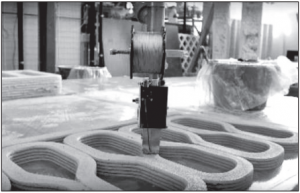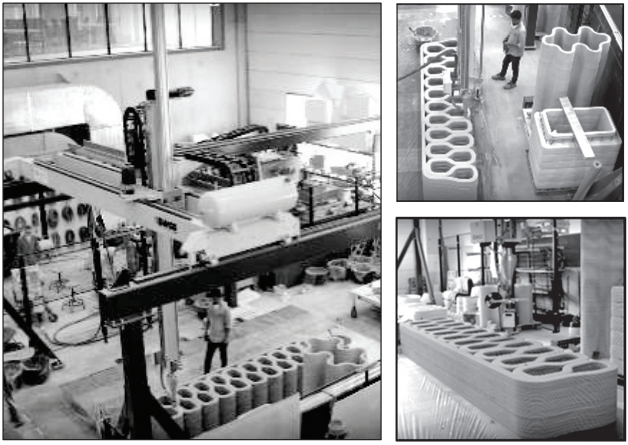The bridge was designed to replace an existing structure over a small local canal. The structure is 3.5 meters wide and spans 6.5 meters. It consists of 3D printed elements that are rotated 90 degrees after printing, then pressed together by post-tensioned prestressing tendons.
“The need to print and stack several single elements with a hollow core by itself makes it self-evident to prestress the components to overcome the lack of bending moment resistant of unreinforced concrete; a technology commonly used in the construction industry,” the researchers state. “So, prestress tendons are placed in the openings of the printed elements, stressed, anchored at the beginning and the end, and finally released. The printed concrete elements are stressed to a level that only compression remains in the section, and no additional passive reinforcement in that direction is required.”
The cross-section of the bridge consists of a series of connected bottle shapes, alternatively positioned upside down and combined with a continuous connecting straight line at the bottom. At the front and the end of the 3D printed bridge elements, two solid concrete bulkheads, traditionally cast and reinforced, are added to introduce the pre-stress forces.
The height of each element is about 1.08 meters, or 89 to 90 layers of 12 mm each. Six elements compose the bridge. Altogether, the bridge has 582 printed layers, each 25.1 meters in length, and a total print path length of 13.4 km. To avoid brittle failure due to torsion in the bridge deck case, a reinforcement cable was introduced in the concrete “filament.” This reinforcement consists of a thin, strong steel cable that becomes embedded in the concrete during printing, thanks to a Reinforcement Embedding Device (RED) developed at TU/e.
Structural integrity was tested with a 1:2 model. A crack appeared, but it was induced by bending, rather than shear failure.
“A final full-scale test was performed in-situ to guarantee the bridge to behave as expected,” the researchers state. “The resulting deflections were too small to measure. As also no other response was observed, and in consideration of the previous material and scale testing, the bridge was considered to comply with the Dutch building regulations.”
The bridge opened to pedestrian and bicycle traffic in October of last year. This was the first 3D printed bridge that was created with the developers’ particular combination of prestressing, reinforcing and 3D printing. Additionally, it is used by regular traffic and must adhere to all local laws and regulations. It is tiny bridge, but it shows us that 3D printing can be a reliable, safe method of construction. And the bridge was only the beginning for TU/e, which is part of a new project that will be 3D printing five concrete houses in Eindhoven over the next five years. The homes will be occupied once they are completed.
Discuss this and other 3D printing topics at 3DPrintBoard.com or share your thoughts below.
Subscribe to Our Email Newsletter
Stay up-to-date on all the latest news from the 3D printing industry and receive information and offers from third party vendors.
Print Services
Upload your 3D Models and get them printed quickly and efficiently.
You May Also Like
Could 3D Printing for Biocomputing Make Wetware Aware?
As an AI arms race consumes ever more electricity, and every ChatGPT search query costs $0.36, the search for new ways of computing has intensified. One answer could be in better...
Bambu Lab Launches Software to Manage 3D Printer Fleets—No Cloud Needed
Bambu Lab has introduced a new software tool, Bambu Farm Manager, designed to help users manage large fleets of 3D printers over a local network, without relying on the cloud....
Consolidation in AM: How 2025 Is Shaping the Industry’s New Normal
The first half of 2025 has been marked by a clear shift in the additive manufacturing (AM) industry. Companies are no longer just focused on developing new tech by themselves....
3D Printing News Briefs, July 2, 2025: Copper Alloys, Defense Manufacturing, & More
We’re starting off with metals in today’s 3D Printing News Briefs, as Farsoon has unveiled a large-scale AM solution for copper alloys, and Meltio used its wire-laser metal solution to...



































